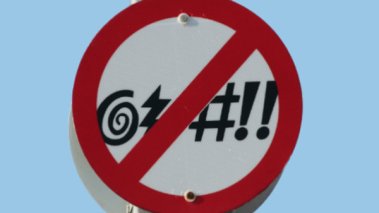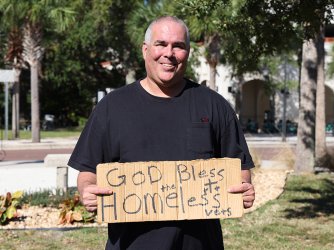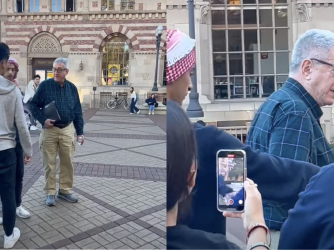Table of Contents
Misconceptions About the Fighting Words Exception

Shutterstock.com
What are fighting words?
The "fighting words" exception to the freedom of speech is widely misunderstood and abused by college administrators. This is, in part, due to the twisted legal path that the doctrine has been down over the last six decades.
The original fighting words doctrine was born out of Chaplinsky v. State of New Hampshire, 315 U.S. 568 (1942). Chaplinsky, a Jehovah’s Witness, was convicted of disturbing the peace for yelling at a local sheriff, “You are a God damned racketeer” and “a damned Fascist” and for further remarking, “the whole government of Rochester are Fascists or agents of Fascists.” The Supreme Court upheld his conviction, creating a narrow category of speech—“fighting words”—that did not enjoy the protections of the First Amendment. The fighting words doctrine, as originally announced in Chaplinsky, found that two types of speech were not protected—words that by their very utterance inflict injury, and speech that incites an immediate breach of the peace.
It is the former category that has spawned most of the confusion. Campus censors frequently cite this to legally justify policies that prohibit offensive or indecent language, even though subsequent case law has effectively invalidated this portion of Chaplinsky’s holding.
What aren't fighting words?
Seven years after the decision, the Supreme Court began to limit the Chaplinsky holding. In Terminiello v. Chicago, 337 U.S. 1 (1949), the petitioner, a preacher, was convicted of disturbing the peace for delivering a fiery speech to a large, restless crowd in which he denounced various political and ethnic groups. In invalidating his conviction, the majority stated:
[The] function of free speech under our system of government is to invite dispute. It may indeed best serve its high purpose when it induces a condition of unrest, creates dissatisfaction with conditions as they are, or even stirs people to anger. Speech is often provocative and challenging. It may strike at prejudices and preconceptions and have profound unsettling effects as it presses for acceptance of an idea. That is why freedom of speech, though not absolute, is nevertheless protected against censorship or punishment. (Internal citation omitted.)
The Court refused to find that Terminiello’s speech fell within the fighting words exception. Over the next few decades, the Supreme Court continued to narrow the fighting words doctrine and to extend First Amendment protections to offensive or vulgar speech.
The Supreme Court was once again confronted with defining fighting words in Cohen v. California, 403 U.S. 15 (1971). Cohen, the petitioner, was convicted of disturbing the peace for wearing a jacket with “Fuck the Draft” emblazoned on it into a courthouse. In invalidating his conviction, the Court ruled that offensive language did not constitute fighting words. The majority held that fighting words were only “those personally abusive epithets which, when addressed to the ordinary citizen, are, as a matter of common knowledge, inherently likely to provoke violent reaction.”
The very next year, in Gooding v. Wilson, 405 U.S. 518 (1972), the Court cited Cohen and stated that speech that is “vulgar or offensive…is protected by the First and Fourteenth Amendments.” Then, the very next term, the Court reaffirmed this stance in Hess v. Indiana, 414 U.S. 105 (1973) by finding that the pronouncement “we’ll take the fucking street later” did not constitute fighting words.
In assessing the fighting words doctrine at this point, it is important to note the speech involved in Gooding. While assaulting a police officer, Gooding shouted, “White son of a bitch, I’ll kill you.” “You son of a bitch, I’ll choke you to death.” and “You son of a bitch, if you ever put your hands on me again, I’ll cut you all to pieces.” If this speech doesn’t constitute fighting words, one would be hard-pressed to think of speech that would qualify.
Gooding was the nail in the coffin—if the fighting words exception has any real vitality left at all (and many commentators, including Nadine Strossen, think it is essentially dead) the Supreme Court has effectively limited the exception to only include abusive language, exchanged face to face, which would likely provoke a violent reaction.
Is the 'fighting words' doctrine still alive on college campuses?
It now seems clear that lewd, vulgar, or profane speech doesn’t fall within the fighting words exception. But someone forgot to tell college administrators, who continue to try to use the fighting words doctrine to punish and censor students. This is probably because the Supreme Court has never expressly overruled its holding in Chaplinsky. Either as the result of confusion or bad faith, many administrators ignore the modifications made by the Supreme Court and use the original holding as a legal justification to censor offensive, vulgar, and profane speech. One example of this can be found at UNC-Charlotte, where the fighting words harassment policy bans “terms or gestures widely recognized to be derogatory references to race, ethnicity, religion, gender, sexual orientation, disability, and other personal characteristics.”
Administrators would be wise to know that attempts to use the fighting words doctrine to justify censorship have been roundly rejected. Federal courts have refused to use the fighting words doctrine as a justification to uphold university speech codes that regulate offensive or indecent language. See Dambrot v. Central Michigan University, 55 F.3d 1177 (6th Cir. 1995); UWM Post, Inc. v. Board of Regents of the University of Wisconsin System, 774 F. Supp. 1163 (E.D. Wis. 1991); Doe v. University of Michigan, 721 F. Supp. 852 (E.D. Mich. 1989). In Papish v. Board of Curators of the University of Missouri, 410 U.S. 667 (1973), the Supreme Court found that a student newspaper cartoon depicting a policeman raping the Statue of Liberty under the headline “Mother Fucker Acquitted” was protected speech, and a federal appeals courts invalidated, on free speech grounds, a punishment for a fraternity that hosted an “ugly woman” contest featuring a performer in blackface. Iota Xi Chapter of Sigma Chi Fraternity v. George Mason University., 993 F.2d 386 (4th Cir. 1993). These cases demonstrate, beyond a shadow of a doubt, that public colleges cannot constitutionally punish indecent or offensive speech merely by branding the speech “fighting words.”
Unfortunately, either knowingly or unknowingly, administrators still to this day attempt to use the fighting words doctrine to justify punishing students for offensive speech. But those decisions often take place behind the closed doors of a disciplinary committee hearing or are used as a “bargaining chip” to force students to submit to mandatory “tolerance” education or face a higher punishment.
These unfortunate abuses of "fighting words" offer yet another example of why you must know your rights. Educate yourself, find local attorneys or professors to host free speech seminars, bring in outside speakers to discuss the First Amendment, and get a free copy of FIRE’s Guide to Free Speech on Campus.
FIRE, a First Amendment charity, effectively and decisively defends the fundamental rights of tens of thousands of students and faculty members on our nation’s campuses while simultaneously reaching millions on and off campus through education, outreach, and college reform efforts.
Recent Articles
FIRE’s award-winning Newsdesk covers the free speech news you need to stay informed.


FIRE Statement: X Corp's lawsuit and Texas's investigation into Media Matters for America are deeply misguided

Anonymous speech is as American as apple pie
